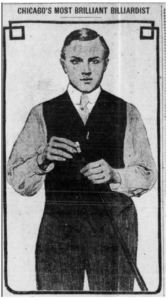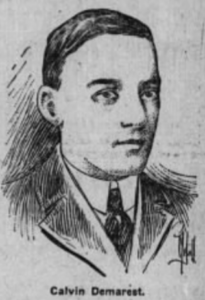In just six short years, the celebrated champion went from competitor to crazed inmate — and then he died in obscurity.
________________________________________________
By Sam Korte
EDITOR’S NOTE: Sam Korte is the author of Greenleaf: Pool’s Greatest Champion, which is available in paperback and digitally. In this article, Mr. Korte describes the life of one of pool’s earliest — and most troubled — champions.
Billiards has no shortage of tragic champions, but Calvin Demarest’s descent from world champion to a lunatic asylum during the early 20th Century marks one of our sport’s most shocking falls. In just six short years, the celebrated champion went from competitor to crazed inmate — and then he died in obscurity.
Calvin Demarest was born in 1888, on June 20, but unlike many billiard greats, he did not pick up a cue as a pre-teen. Instead, Demarest began seriously pursuing billiards at age 14, when he sought out formal training at the Chicago Athletic Association and from world champion and legend Jacob Schaefer. For the first 6 months of this training, Demarest’s practice and “play” were limited to stroking a cue without touching a ball. He “formed bridges and worked for a graceful and easy swing of stroke,” according to a 1907 Associated Press account. Only once his mechanical stroke was mastered did Schaefer begin teaching Demarest the art of playing carom billiards. Demarast never abandoned this rigorous and sometimes tedious practice style — it followed him for the rest of his life, and, indeed, became a hallmark of his career.
Demarest soon became Chicago’s top amateur billiards player — excelling at both 14.1 straight pool and 18.2 balkline (an early variation of pocketless carom billiards). By 1907, he was the nation’s top amateur, winning the 14.1 amateur championship. In 1908 he won the 18.2 amateur championship, and in 1909 he turned turned pro. Experts could see his potential early on, predicting he would soon equal — if not actually surpass — the great Willie Hoppe. His supporters at the Chicago Athletic Association even landed him a cozy desk job at the Chicago Stock Exchange so he could dedicate more time to perfecting his game.
Crazy Billiards
The timing for all this was excellent, given that billiards — and particularly carom billiards — was then near the height of its popularity. As such, most American adult men during the 1910s would have been familiar with the rules of the sport, its leading players, and even strategies. They would have known, for instance, that billiards — and especially balkline — is characterized by slow and deliberate play. Balls must be carefully nursed and positioned as a single errant shot may leave a winning opening for your opponent. Defense comes first, second, and third. Demarest, however, was different. While most professionals avoided risk, Demarest — as legendary billiards writer and player Maurice Daly once put it — played “crazy billiards.” He raced around the billiards table with reckless abandon, as if on “roller skates,” and would start lining up his next shot even before the balls from the previous one had come to rest. He preferred to slam the balls in and he selected shots that other professionals — and even rank amateurs — would never consider. But his massé shots were without equal and the billiard crowds of the time loved his unconventional playing style.
Demarest’s rapid play also matched his rapid rise to professional world champion. He took the 18.2 billiard championship in December 1909, and his final match to win it (against George Sutton), may have been the fastest 18.2 match ever played: it took Demarest just over an hour to score the requisite 500 points. In the coming years, Demarest would remain one of billiards’ top professionals, routinely playing Hoppe and other greats at headline events. He also placed near the top of the various professional billiard leagues that formed each year.
Descent Into Madness
1915 began as a typical year for Demarest. In January through April, he competed in the Champion’s Billiard Players’ League, finishing a very respectable second. He likewise had a good chance of competing later in the year for another world championship. On June 16th, however, he snapped.
 According to news reports, Demarest attacked his wife with a knife, plunging it into her throat and chest. His mother attempted to intervene, but he slashed her hands. Demarest then turned the knife on himself, ending the rampage. Police soon arrived, rushing all three to the hospital. They would survive, but Mrs. Demarest would divorce Calvin a few weeks later and Demarest eventually was committed to an insane asylum — the Wilgus sanitarium — and his mental condition never improved. According to reports, his mind was so seriously affected, he no longer recognized his friends when they visited. He would be kept on suicide watch for the remainder of his life.
According to news reports, Demarest attacked his wife with a knife, plunging it into her throat and chest. His mother attempted to intervene, but he slashed her hands. Demarest then turned the knife on himself, ending the rampage. Police soon arrived, rushing all three to the hospital. They would survive, but Mrs. Demarest would divorce Calvin a few weeks later and Demarest eventually was committed to an insane asylum — the Wilgus sanitarium — and his mental condition never improved. According to reports, his mind was so seriously affected, he no longer recognized his friends when they visited. He would be kept on suicide watch for the remainder of his life.
Demarest never identified what caused his 1915 breakdown. His wife claimed he had been having multiple affairs, and when confronted, he attacked her. His friends said he had been having delusions in the months leading up to the tragedy, believing his wife and other loved ones were conspiring against him. Others thought the constant stress of professional billiards play, along with Demarest’s never ending practice routines, drove him to madness.
But whatever the case, it’s undeniable that Demarest dazzled fans even as he struggled with his own mental health. And eventually, those struggles became too great for him. On June 12, 1925, Calvin Demarest died in Illinois, purportedly while still institutionalized.
________________________________________________
Sam Korte is the author of Greenleaf: Pool’s Greatest Champion, which is available from your favorite online retailer.




Recent Comments